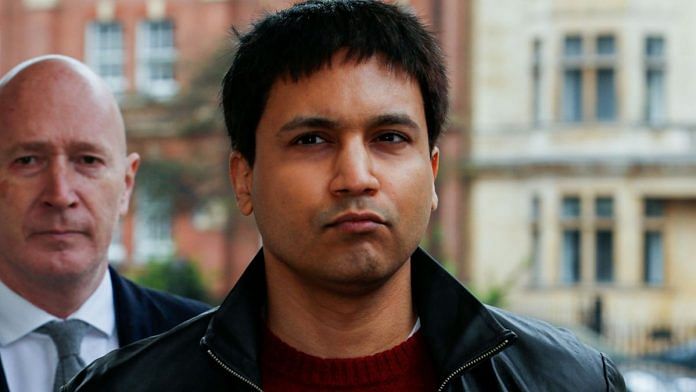London: In the end, the Navinder Sarao story got the Hollywood ending it deserved.
Five years after the trader was arrested in his parents’ suburban London home for manipulating markets, the 41-year-old was ordered by a U.S. judge to go back there for a year of house arrest, holed up in the same bedroom where he had committed his crimes. The “Hound of Hounslow,” as he was dubbed in the British press, was grounded.
During Tuesday’s sentencing hearing in Chicago, even the prosecutors urged the judge to let Sarao go home a free man, citing his autism diagnosis and his “extraordinary cooperation” in helping the government build other cases. But U.S. District Judge Virginia Kendall insisted that the serial spoofer face some kind of punishment for endangering the global economy, beyond the four months he’d already served in the U.K.
Sarao may have treated markets like a computer game, Kendall said, but that “does not impact the seriousness of what happened” on May 6, 2010, when markets lost $1 trillion in five minutes before rebounding. Exactly how much Sarao’s trading contributed to the so-called Flash Crash remains a subject of considerable debate.
The sentencing caps one of the more remarkable financial stories in recent memory, one that reveals much about the precarious nature of modern electronic financial markets and the failure of regulators and exchanges to adequately police them.
Messi memorabilia
Sarao learned to trade in an arcade above a supermarket after applying to a newspaper ad in 2003. From nothing, he built a bankroll of millions of dollars, buying and selling S&P 500 futures while wearing a tracksuit and a pair of red, heavy-duty ear defenders to block out sound. After a few years, he returned to his bedroom to trade alone, surrounded by stuffed animals and Lionel Messi memorabilia, according to court documents.
Sarao made tens of millions of dollars, but he didn’t tell his family or friends because he was worried they would treat him differently. His most extravagant purchase was a secondhand Volkswagen. But when a new breed of ultrafast, sophisticated market participants known as high-frequency traders showed up and squeezed day traders like Sarao out of the market, he took a fateful decision to fight back, paying a programmer to build a machine he called the NAVTrader.
The program, which allowed Sarao to place and then cancel huge orders, tricking HFT firms’ algorithms, proved wildly effective: On his most successful day, Sarao made more than $4 million. But it also destabilized markets, according to the U.S. Department of Justice, including on the already volatile day of the Flash Crash.
It would take another five years and an eagle-eyed whistle-blower for Sarao to get caught. In that time, he entrusted his winnnings to a cast of unscrupulous investors who promised him guaranteed, double-digit returns. Instead, he lost everything he made — about $70 million, according to his lawyers — something they only discovered when they were trying get $5 million together for bail.
Plot twist
While Sarao was awaiting extradition to the U.S., he became a folk hero to many, the David standing up to the industry’s billion-dollar Goliaths, whose own controversial tactics had been highlighted in Michael Lewis’s best-selling “Flash Boys.” Still, his legal team faced an uphill struggle. Sarao had kept incriminating videos of himself trading and sent emails to a programmer spelling out his desire to “spoof (the market) down.”
Faced with little alternative, he struck a deal in 2016, pleading guilty to spoofing and wire fraud, felonies carrying maximum sentences of 10 and 20 years respectively. At the time, it seemed inconceivable he wouldn’t spend at least a few years in prison.
Once again, there was a twist in the tale. Sarao was only the second person to be criminally prosecuted for the relatively new offense of spoofing, and at the time of his arrest, the agents and prosecutors at the Justice Department and the Commodity Futures Trading Commission were fairly naive about the dark arts of the new electronic markets.
In a series of debriefings reminiscent of the movie “Catch Me If You Can,” Sarao walked them through his home videos and explained how to identify market cheats in the order book. With the information he provided, the government reprogrammed the software it uses to identify manipulation. Since then, more than a dozen people have been charged with spoofing, including from some of the HFT firms Sarao so detested, according to prosecutors.
Before he was sentenced, Sarao asked to say a few words. “I spent 36 years trying to find happiness on a path built on a lie,” Sarao said, reading from a sheet of paper in a quiet voice. “I did the things society says will give you happiness, and when they didn’t I didn’t know where to look.”
Sarao had been addicted to trading, he told the judge, but during his time in prison he came to realize that it wasn’t bringing him any deeper meaning. “Money doesn’t buy you happiness,” he said. “And I’m glad I know that now.”-Bloomberg
Also read: No more jail time for Indian-origin, autistic futures trader behind 2010 Flash Crash in US



